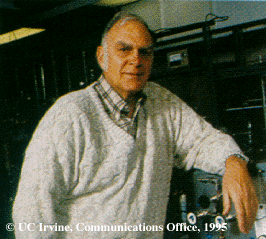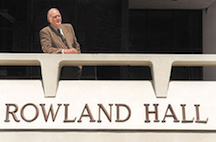
This excerpt from my book is a tribute to Dr. Sherwood Rowland who was awarded the Nobel Prize for his co-discovery of how CFCs were destroying our atmosphere. He died on March 10, 2012 at the age of 84. His wife Joan survives him. They would have celebrated their 60th wedding anniversary this June. He was a brilliant researcher and an engaging teacher. I was fortunate to be one of his students at UCI.
Attack of the Killer Hairspray
By John Addison. A thin layer of ozone in the stratosphere protects us from getting zapped and fried by gamma rays, x-rays, and ultraviolet rays. This ozone shield was saved thanks to the brilliant work of Nobel Prize chemists Dr. Sherwood Rowland, Dr. Mario Molina, and Dr. Paul Crutzen.
I interviewed my former chemistry professor, Dr. Rowland, to understand the difficult process of scientific discovery, industry opposition, global treaties, and winning the Nobel Prize. Several scientists contributed to our understanding of the atmospheric shield. This is one man’s story – Dr. Sherwood Rowland.
When Dr. Rowland’s breakthrough occurred, chlorofluorocarbons (CFCs) were used in everything from hairsprays to air conditioners. DuPont and a few other chemical companies were making billions from CFCs and similar chemicals.
Drs. Rowland and Molina questioned the conventional thinking that if the gases were inert at ground level, then they would not breakdown under any conditions. Sherwood Rowland recalled, “We realized that CFC molecules could rise into the atmosphere where sunlight is far more intense and then breakdown, freeing chlorine atoms. Under laboratory conditions, we created a chemical reaction demonstrating that chlorine is activated on the surface of ice cloud particles in the polar stratosphere.”
Returning home from a long day in the lab, Sherwood’s wife Joan asked him how is research was going. Dr. Rowland replied, “The work is going well, but it looks like the end of the world.”
The results were frightening. Dr. Rowland discovered that CFCs would rise in the stratosphere, breakdown, and free chlorine atoms which destroy ozone molecules for at least 100 years. In 1974, Dr. Rowland and Dr. Molina published a seminal paper in Nature Magazine on the CFC destruction of the stratospheric ozone layer.
Predictably, businesses that were making billions by producing CFCs launched a campaign to discredit the research, disparage the scientists, and go for another good quarterly earnings report.
DuPont and other chemical manufacturers argued that millions would die without refrigeration and air conditioning. Life as we know it would end with people having “bad hair” days. “Aerosol Age Magazine published an article stating that we were probably agents of Russia’s KGB,” Dr. Rowland recalled with a weary smile.
DuPont argued that substitutes could not be created for CFCs. As we know by looking back 30 years, substitutes were created by DuPont and others. Human life was preserved, and DuPont profits continued to grow.
The Unlikely KGB Agent
What takes someone down the one-in-a-million path to being recognized as a Nobel Laureate? Rowland grew-up in a small town in Ohio in a loving family. Sherwood Rowland demonstrated an early passion for mathematics and science. There was no television in his childhood to distract him from reading and learning. As a young teenager, he was allowed to collect temperatures and precipitation data for the local weather station. He was proficient in all studies and graduated high school at age 15.
Sherwood Rowland excelled when he attended Ohio Wesleyan University, graduating with all “A’s”. Contrary to later personal attacks that questioned his loyalty, Rowland demonstrated his America patriotism by volunteering and serving in the United States Navy during World War II.
Rowland’s doctoral studies at the University of Chicago included the good fortune to be assigned as a mentor Dr. Willard Libby, who had just finished developing the carbon-14 dating technique for which he received the Nobel Prize. He was also able to study with Nobel laureates Drs. Enrico Fermi, Henry Taube, Maria Goeppert Mayer, and Harold Urey. By the time that Dr. Rowland discovered the damage to the ozone, he had progressed from teaching at Princeton to being a full professor and chairman of the chemistry department at U.C. Irvine, where his ozone discovery was made.
Ten Years under Attack
 For ten long years, from 1974 to 1984, Dr. Rowland and Dr. Molina continued to be attacked by the chemical industry. Even though no one could find flaws in the chemical equations, manufacturers insisted that absolute proof should be secured before taking any action.
For ten long years, from 1974 to 1984, Dr. Rowland and Dr. Molina continued to be attacked by the chemical industry. Even though no one could find flaws in the chemical equations, manufacturers insisted that absolute proof should be secured before taking any action.
During these ten years of struggle, the banning of the killing CFCs did not start with a global agreement; it started with grass roots efforts. Local nonprofit groups campaigned for local bans. Earth Day events educated.
Citizens of Oregon showed early leadership by actively campaigning to save the protective ozone shield. Oregon accepted the chemistry and banned use of aerosol in 1975. Aerosol damage got media attention to the point that it was even debated on TV’s most popular show – All in the Family. Celebrities and super models gave-up their hairspray and went natural.
Dr. Rowland remembered, “Leading scientists started taking us seriously in 1976, when the National Academy of Sciences accepted our research.” In 1977, the United Nations Environment Program (UNEP) Governing Council adopted the World Plan of Action on the Ozone Layer.
An Image from Space
In the late 1970s, the first scientists that measured actual ozone depletion were so surprised that they believed their instruments had malfunctioned. Tragically, they did not publish their findings for years, not until 1984 when the British Antarctic Survey published their findings that ozone levels had dropped a frightening 35 percent in only 20 years. The U.S. satellite Nimbus-7 confirmed the results with images from space.
Ten long years after Dr. Rowland and Dr. Molina first published their CFC findings, they finally had empirical proof – an ozone hole over the Antarctic. After suffering years of industry sound-bite attacks, the good scientist started to develop his own clever remarks. When interviewed by newspapers and TV, Rowland quipped, “First they said there was no ozone problem, now you can see it from Mars.”
Ordinary people witnessed the hard evidence on television and in magazines showing satellite images of a life threatening hole in the ozone. Public pressure intensified for all nations to take action. The United States, Canada, Scandinavian countries, and several other nations, imposed bans on CFCs as aerosol propellants when used in antiperspirants, hairsprays and deodorants. These forward thinking nations did not wait for all nations to agree, they did not even wait for most nations. They took action.
In Montreal, Canada, on September 16, 1987, the Montreal Protocol on Substances that Deplete the Ozone Layer was signed into agreement by 24 major countries of the world, including the United States. These countries recognized that it was critical to be leaders, rather than wait years for all nations to agree.
A process for nations to phase-out production of dangerous CFCs and halons was established. Later, other dangerous chemicals were added to the list. The agreement was strengthened in Copenhagen. Developing countries were giving extra years to comply. Now 191 nations have agreed to the Montreal Protocol and are phasing-out the destructive gases.
Many brave leaders in science, government, and industry are taking action inspired by the work of Sherwood Rowland and his colleges. Twenty-one years after their published research, Dr. Rowland, Dr. Molina, and Dr. Crutzen were awarded the 1995 Nobel Prize in Chemistry. This is the highest recognition a scientist can achieve.
Now a new generation of scientists – the Intergovernmental Panel on Climate Change (IPPC) has been awarded the Nobel Prize after suffering years of attack on their scientific integrity for documenting the tragic effects of increasing carbon dioxide and other greenhouse gas emissions.
The Montreal Protocol is proof that the major nations of the world can agree to take climate action. We now hope for a new climate agreement that protects our future. It does not need to be perfect, but it does need leadership from the United States and China if other nations are to take action.
Living near the Pacific Ocean, Sherwood Rowland once broke his arm in big waves as he rescued one of his graduate students caught between rocks and pounding surf. Sherwood Rowland put his life on the line to rescue another. In fact, he rescued all of us.
This post is an excerpt from John Addison’s book – Save Gas, Save the Planet.
